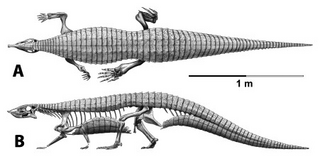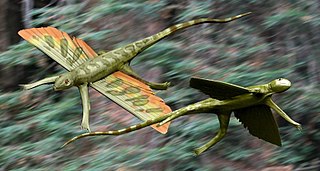
Herrerasauridae is a family of carnivorous dinosaurs, possibly basal to either theropods or even all of saurischians, or even their own branching from Dracohors, separate from Dinosauria altogether. They are among the oldest known dinosaurs, first appearing in the fossil record around 233.23 million years ago, before becoming extinct by the end of the Carnian stage. Herrerasaurids were relatively small-sized dinosaurs, normally no more than 4 metres (13 ft) long, although the holotype specimen of "Frenguellisaurus ischigualastensis" is thought to have reached around 6 meters long. The best known representatives of this group are from South America, where they were first discovered in the 1930s in relation to Staurikosaurus and 1960s in relation to Herrerasaurus. A nearly complete skeleton of Herrerasaurus ischigualastensis was discovered in the Ischigualasto Formation in San Juan, Argentina, in 1988. Less complete possible herrerasaurids have been found in North America and Africa, and they may have inhabited other continents as well.

Lepidosauromorpha is a group of reptiles comprising all diapsids closer to lizards than to archosaurs. The only living sub-group is the Lepidosauria, which contains two subdivisions, Squamata, which contains lizards and snakes, and Rhynchocephalia, the only extant species of which is the tuatara.
Velocipes is a saurischian dinosaur genus from the Late Triassic that may have been a theropod; its fossils were found in the Norian-age Lissauer Breccia of southern Poland.

Teratosaurus is a genus of rauisuchians known from the Triassic Stubensandstein of Germany. It is estimated to be 6.2 meters (20.35 ft) long.

Stagonolepis is an extinct genus of stagonolepidid aetosaur known from the Late Triassic Hassberge Formation of Germany, the Drawno Beds of Poland, and the Lossiemouth Sandstone of Scotland. Supposed fossils from North and South America have been placed into their own genera, Calyptosuchus and Aetosauroides, respectively.

Metoposaurus meaning "front lizard" is an extinct genus of stereospondyl temnospondyls, known from the Late Triassic of Germany, Italy, Poland, and Portugal. This mostly aquatic animal possessed small, weak limbs, sharp teeth, and a large, flat head. This highly flattened creature mainly fed on fish, which it captured with its wide jaws lined with needle-like teeth. Many Metoposaurus mass graves have been found, probably from creatures that grouped together in drying pools during drought.
Dactylosaurus is a genus of nothosaur in the family Pachypleurosauridae. Along with Anarosaurus, Dactylosaurus was one of the earliest known pachypleurosaurs to come from Europe.
Arganodus is an extinct genus of freshwater lungfish that had a wide global distribution throughout much of the Triassic period, with a single species surviving across Gondwana into the Cretaceous. It is the only member of the family Arganodontidae, although it is sometimes placed in the Ceratodontidae or synonymized with the genus Asiatoceratodus.

Kuehneosauridae is an extinct family of small, lizard-like gliding diapsids known from the Triassic period of Europe and North America.

Ptychoceratodus is an extinct genus of lungfish living from Early Triassic to Middle Jurassic. It was established by Otto Jaekel for one species, transferred from Ceratodus genus. Type species is P. serratus from the Middle Triassic of Switzerland and Germany. Ptychoceratodus had two pairs of massive dental plates, bearing 4-6 acute ridges. Its skull roof was composed from massive, plate-like bones. In the central part of skull roof was localized an unossified fenestra. Most of the Ptychoceratodus findings are isolated dental plates, some associated with jaws. Other parts of skull or postcranial skeleton are relatively rarely found as fossils. The anatomy of skull is the best recognized in P. serratus, whereas less complete cranial material is available also for P. concinuus, P. phillipsi, and P. rectangulus. Although Ptychoceratodus is known exclusively from the Triassic and Jurassic, there were also Cretaceous specimens referred to this genus. However, they are more often regarded as representants of Metaceratodus. Ptychoceratodus is the only member of the family Ptychoceratodontidae. The first named species is P. phillipsi by Louis Agassiz in 1837 as a species of Ceratodus and later moved to Ptychoceratodus genus. Occurrences of Ptychoceratodus come mainly from Europe. However, occurrences from other continents suggest it was dispersed globally during the Triassic. After 2010, the new fossil material behind the Europe was reported from South America, India, and Greenland

Sargodon is an extinct genus of neopterygian ray-finned fish that lived during the Middle and Late Triassic epochs in what is now Europe.

Protosuchidae is a family of basal crocodyliform reptiles that lived from the Late Triassic to the Late Cretaceous. This family should not be confused with Protosuchia, which is an informal evolutionary grade of primitive crocodiliforms
Protanystropheus is an extinct genus of archosauromorph from the Middle Triassic of Poland, Germany, Austria and the Netherlands. It was named by Sennikov in 2011 and the type species is Protanystropheus antiquus, first described in 1908 by German paleontologist Friedrich von Huene under the name Tanystropheus antiquus. Sennikov (2011) referred to Protanystropheus several vertebrae, including those belonging to "Thecodontosaurus" primus, but such a referral has later been questioned, because these specimens may represent other basal archosauromorphs.
Meyerosuchus is an extinct genus of mastodonsauroidean temnospondyl. Fossils have been found from the Early Triassic Hardegsen Formation in southern Germany. Meyerosuchus is present in late Olenekian deposits of the Middle Buntsandstein. The type species M. fuerstenberganus was named in 1966, although remains have been known since 1855. Meyerosuchus is closely related to Stenotosaurus; both genera are grouped in the family Stenotosauridae and the two genera may even be synonymous.

Smok is an extinct genus of large carnivorous archosaur. It lived during the latest Triassic period. Its remains have been found in Lisowice, southern Poland. The only species is Smok wawelski and was named in 2012. It is larger than any other known predatory archosaur from the Late Triassic or Early Jurassic of central Europe. The relation of Smok to other archosaurs has not yet been thoroughly studied; it may be a rauisuchid, prestosuchid, an ornithosuchid pseudosuchian or a theropod dinosaur.

Kuehneosuchus is an extinct genus of Late Triassic kuehneosaurid reptile known from the Late Triassic of southwest England. It was named by P. L. Robinson in 1967 and the type and only species is Kuehneosuchus latissimus. It is known from the holotype NHMUK PV R 6111, a set of associated vertebrae and ribs. It is a derived kuehneosaurid, most closely related to Kuehneosaurus. The genera are very similar and can be distinguished from one another primarily on the length of their "wing" ribs, relatively short and massive in Kuehneosaurus but up to 4 times longer and more gracile in Kuehneosuchus. However, the skull and major postcranial bones are identical in both taxa, as their age and horizon. According to aerodynamic studies Kuehneosuchus, unlike Kuehneosaurus which may be a species of the same genus or represent a different sexual morph, was probably a glider.
Tatrasuchus is an extinct genus of temnospondyl from the Middle Triassic of Poland and Germany. It is classified as a member of the family Cyclotosauridae or Mastodonsauridae. It is closely related to the genus Cyclotosaurus. The type species, Tatrasuchus kulczyckii, was named in 1996. Damiani (2001) considered genus Kupferzellia Schoch (1997) from the Middle Triassic of Germany to be a junior synonym of Tatrasuchus, and recombined its type species, K. wildi as the second species of Tatrasuchus. This classification was followed by some authors, e.g. Fortuny et al. (2011); other authors, e.g. Schoch (2008), maintain Tatrasuchus and Kupferzellia as distinct genera. However, Schoch & Moreno (2024) synonymized the two genera, maintaining T. wildi as a distinct species from T. kulczyckii.

Lisowicia is an extinct genus of giant dicynodont synapsid that lived in what is now Poland during the late Norian or earliest Rhaetian age of the Late Triassic Period, about 210–205 million years ago. Lisowicia is the largest known dicynodont, as well as the largest non-mammalian synapsid, reaching about 4.5 metres (15 ft) long, standing up to 2.6 metres (8.5 ft) tall at the hips and weighing around 5–7 metric tons, comparable in size to modern elephants. It was also one of the last dicynodonts, living shortly before their extinction at the end of the Triassic period. Fossils of a giant dicynodont were known from Poland since 2008, but Lisowicia was not named and officially described as a new species until late 2018.
Dromatheriidae is an extinct family of prozostrodontian cynodonts, closely related to mammals. Members of the family are known from the Late Triassic of India, Europe and North America. Apart from a few jaw fragments, dromatheriids are mainly known from their sectorial (flesh-slicing) postcanine teeth. The teeth were fairly typical among early prozostrodontians, as they were labiolingually compressed, with a single root and crown hosting a longitudinal row of sharp cusps. Dromatheriids in particular have a very narrow and symmetrical crown without a prominent cingulum.
Hallautherium is an extinct genus of morganucodont mammaliaforms from the Late Triassic of Europe. The type species H. schalchi is known from the Klettgau Formation of Switzerland. In addition, a molariform tooth referable to the genus has been found in Poland.
















